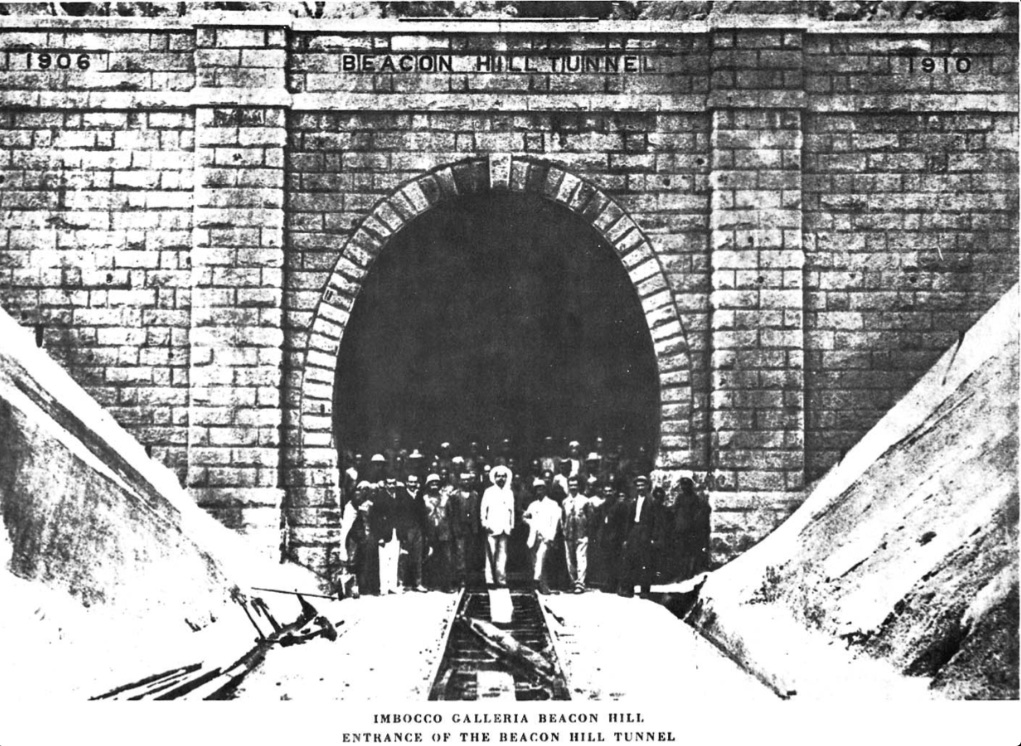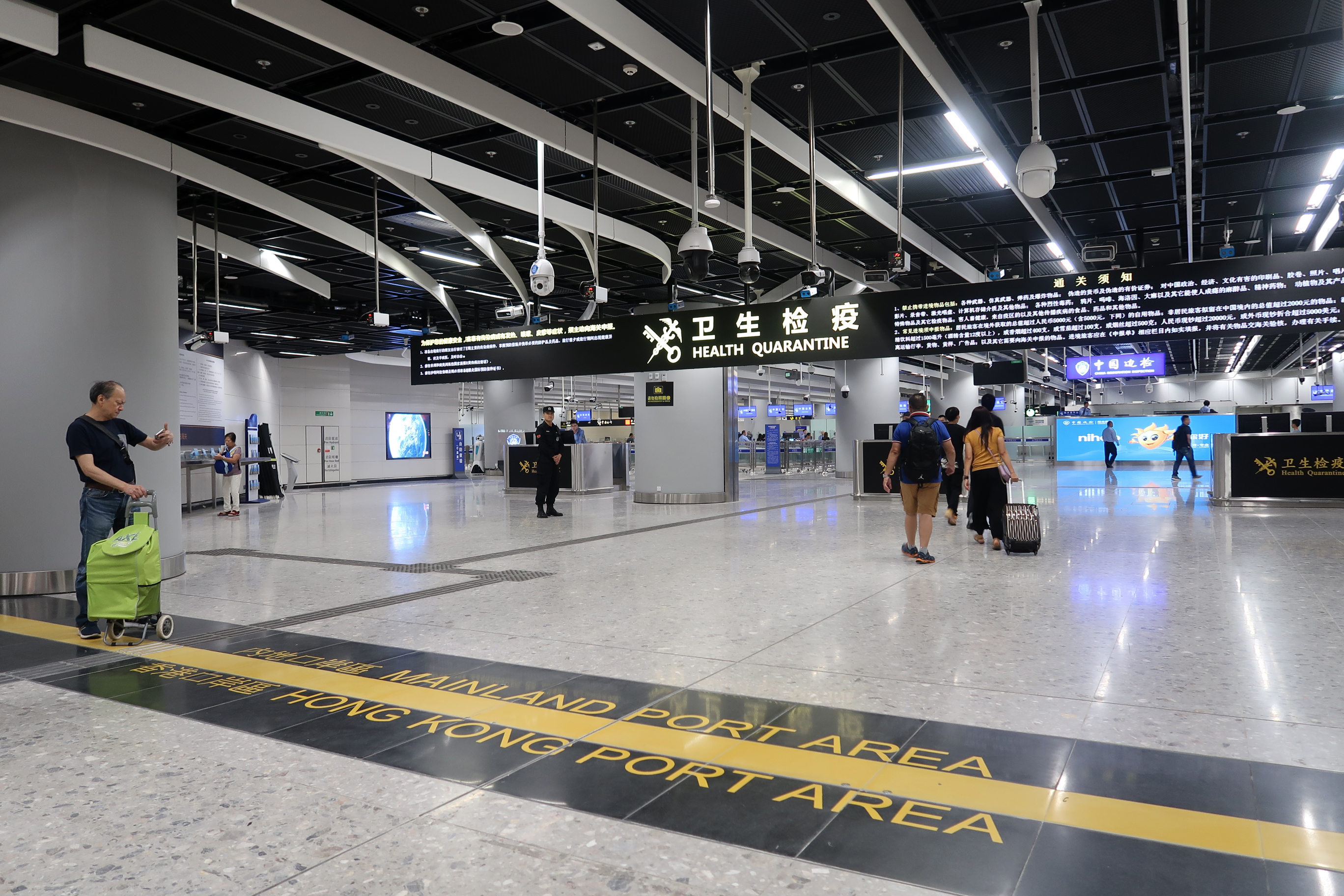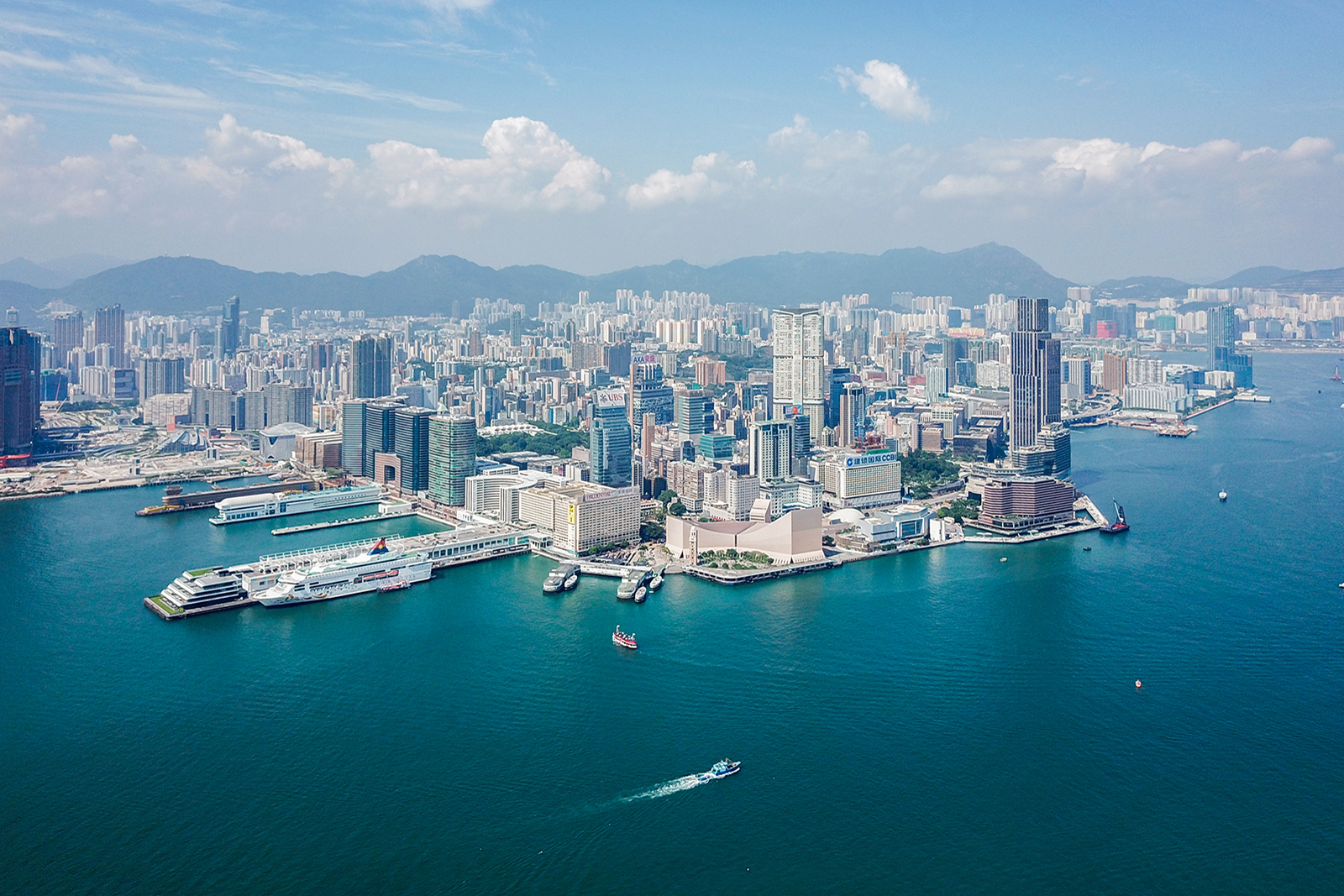|
Kowloon Railway Station (KCR)
Kowloon station (), colliquially Old Tsim Sha Tsui Terminal, located in Tsim Sha Tsui on the present site of the Hong Kong Cultural Centre, was the former southern terminus of the Kowloon–Canton Railway (KCR). History The first Kowloon station was a temporary structure built near the (now demolished) Post Office on Salisbury Road in 1909 and served until the permanent station was completed. Regular service between Canton and Kowloon began on 1 October 1910. The new station was designed by Arthur Benison Hubback and built on reclaimed land overlooking the harbour. Work on the foundations started in May 1913, and the construction of the station began on 1 March 1914. It was completed on 1 March 1916, and the station was officially opened on 28 March 1916. The building consisted of a two-storey L shaped terminal building with a clock tower. It was designed in a Edwardian Classical Revival style, and built had a steel frame with red brick cladding as well as white granite colu ... [...More Info...] [...Related Items...] OR: [Wikipedia] [Google] [Baidu] |
Kowloon–Canton Railway
The Kowloon–Canton Railway (KCR; ) was a railway network in Hong Kong.Legislative Council information paper CB(1)357/07-08(0 THB(T) CR 8/986/00, CB(1)1749/07-08(0/ref> It was owned and operated by the Kowloon-Canton Railway Corporation (KCRC) until 2007. Rapid transit services, a light rail system, feeder bus routes within Hong Kong, and intercity passenger and freight train services to China on the KCR network, have been operated by the MTR Corporation since 2007. While still owned by its previous operator, the KCR network (which is wholly owned by the Hong Kong Government through the KCRC) has been operated by the MTR Corporation Limited under a 50-year, extendible, service concession since 2 December 2007. The two companies have merged their local metro lines into one unified fare system. Immediately after the merger, steps were taken to integrate the network into the same fare system as the MTR, and gates between the two networks were removed in several stages in 2008 ... [...More Info...] [...Related Items...] OR: [Wikipedia] [Google] [Baidu] |
Governor Of Hong Kong
The governor of Hong Kong was the representative of the British Crown in Hong Kong from 1843 to 1997. In this capacity, the governor was president of the Executive Council and commander-in-chief of the British Forces Overseas Hong Kong. The governor's roles were defined in the Hong Kong Letters Patent and Royal Instructions. Upon the end of British rule and the handover of Hong Kong to China in 1997, most of the civil functions of this office went to the chief executive of Hong Kong, and military functions went to the commander of the People's Liberation Army Hong Kong Garrison. The governor Authorities and duties of the governor were defined in the Hong Kong Letters Patent and Royal Instructions in 1843. The governor, appointed by the British monarch (on the advice of the Foreign Secretary), exercised the executive branch of the government of Hong Kong throughout British sovereignty and, with the exception of a brief experiment after World War II, no seriou ... [...More Info...] [...Related Items...] OR: [Wikipedia] [Google] [Baidu] |
Monuments And Memorials In Hong Kong
A monument is a type of structure that was explicitly created to commemorate a person or event, or which has become relevant to a social group as a part of their remembrance of historic times or cultural heritage, due to its artistic, historical, political, technical or architectural importance. Some of the first monuments were dolmens or menhirs, megalithic constructions built for religious or funerary purposes. Examples of monuments include statues, (war) memorials, historical buildings, archaeological sites, and cultural assets. If there is a public interest in its preservation, a monument can for example be listed as a UNESCO World Heritage Site. Etymology It is believed that the origin of the word "monument" comes from the Greek ''mnemosynon'' and the Latin ''moneo'', ''monere'', which means 'to remind', 'to advise' or 'to warn', however, it is also believed that the word monument originates from an Albanian word 'mani men' which in Albanian language means 'remember ... [...More Info...] [...Related Items...] OR: [Wikipedia] [Google] [Baidu] |
Former Buildings And Structures In Hong Kong
A former is an object, such as a template, gauge or cutting die, which is used to form something such as a boat's hull. Typically, a former gives shape to a structure that may have complex curvature. A former may become an integral part of the finished structure, as in an aircraft fuselage, or it may be removable, being using in the construction process and then discarded or re-used. Aircraft formers Formers are used in the construction of aircraft fuselage, of which a typical fuselage has a series from the nose to the empennage, typically perpendicular to the longitudinal axis of the aircraft. The primary purpose of formers is to establish the shape of the fuselage and reduce the column length of stringers to prevent instability. Formers are typically attached to longerons, which support the skin of the aircraft. The "former-and-longeron" technique (also called stations and stringers) was adopted from boat construction, and was typical of light aircraft built until the a ... [...More Info...] [...Related Items...] OR: [Wikipedia] [Google] [Baidu] |
Former Kowloon–Canton Railway Stations
A former is an object, such as a template, gauge or cutting die, which is used to form something such as a boat's hull. Typically, a former gives shape to a structure that may have complex curvature. A former may become an integral part of the finished structure, as in an aircraft fuselage, or it may be removable, being using in the construction process and then discarded or re-used. Aircraft formers Formers are used in the construction of aircraft fuselage, of which a typical fuselage has a series from the nose to the empennage, typically perpendicular to the longitudinal axis of the aircraft. The primary purpose of formers is to establish the shape of the fuselage and reduce the column length of stringers to prevent instability. Formers are typically attached to longerons, which support the skin of the aircraft. The "former-and-longeron" technique (also called stations and stringers) was adopted from boat construction, and was typical of light aircraft built until the adv ... [...More Info...] [...Related Items...] OR: [Wikipedia] [Google] [Baidu] |
Defunct Railway Stations In Hong Kong
{{Disambiguation ...
Defunct (no longer in use or active) may refer to: * ''Defunct'' (video game), 2014 * Zombie process or defunct process, in Unix-like operating systems See also * * :Former entities * End-of-life product * Obsolescence Obsolescence is the state of being which occurs when an object, service, or practice is no longer maintained or required even though it may still be in good working order. It usually happens when something that is more efficient or less risky r ... [...More Info...] [...Related Items...] OR: [Wikipedia] [Google] [Baidu] |
Hong Kong West Kowloon Railway Station
West Kowloon station (abbreviated WEK), also known as Hong Kong West Kowloon, is the southern terminus of and the only station on the Hong Kong section of the Guangzhou–Shenzhen–Hong Kong Express Rail Link (HSR). The station connects to China's HSR network across the border through dedicated tunnels and includes a Mainland Port Area where the laws of (Mainland) China are enforced. It was constructed by the MTR Corporation Limited as the project manager commissioned by the Hong Kong Government, through subcontractors. The terminal railway station is located in Jordan, West Kowloon, north of the West Kowloon Cultural District between the Airport Express and Tung Chung line's Kowloon station and the Tuen Ma line's Austin station. The footprint of the new station extends into the basement of the West Kowloon Cultural District. The original While construction of the station was still planned for completion in 2015, major flooding occurred in the railway ... [...More Info...] [...Related Items...] OR: [Wikipedia] [Google] [Baidu] |
East Tsim Sha Tsui Station
East Tsim Sha Tsui () is a station of the Mass Transit Railway (MTR) system of Hong Kong. It is currently an intermediate station on the . The station was built to alleviate surface traffic jams and passenger congestion at Kowloon Tong station. The distance from to the station is about one kilometre with the journey time of around two minutes. This station is linked with Tsim Sha Tsui station of the by subways (underground pedestrian tunnels). History The predecessor of the East Rail line was the Kowloon–Canton Railway (British Section), which was opened in 1910. At the time of opening, its southern terminus was the located in Tsim Sha Tsui, where the Clock Tower stands today. However, the old Kowloon station was closed in 1975, and the southern terminus of the railway was relocated to the newly built Hung Hom station. An early predecessor to the present East Tsim Sha Tsui station, named Mariner in the East Kowloon line 1970 scheme, was intended to provide inter ... [...More Info...] [...Related Items...] OR: [Wikipedia] [Google] [Baidu] |
Tsim Sha Tsui Station
Tsim Sha Tsui is an MTR station on the . The station, originally opened on 16 December 1979 on the , serves the area of Tsim Sha Tsui. East Tsim Sha Tsui station on the , which opened on 24 October 2004, is connected to this station by underground pedestrian passages. The two stations serve as an interchange point between the Tsuen Wan and Tuen Ma lines. History The station was built underneath Nathan Road in the late 1970s. The site of Exit A1 was once the vehicular entrance to Kowloon Park, which was relocated to Haiphong Road. The station opened on 16 December 1979 as part of the Modified Initial System. Service was extended southward, across the harbour, on 12 February 1980. Before the Tsuen Wan Extension opened, the single line of the MTR traveled from Central to Kwun Tong (whereas today all northbound trains from Tsim Sha Tsui go to Tsuen Wan). The station concourse was renovated in 1986. Tsim Sha Tsui station was featured in Clifton Ko's 1987 film, ''It's a Mad, Mad, ... [...More Info...] [...Related Items...] OR: [Wikipedia] [Google] [Baidu] |
Ho Tung Lau
Ho Tung Lau () is a former area northeast of Lok Lo Ha in Sha Tin, near the MTR and on the former shore of Sha Tin Hoi, in the New Territories, Hong Kong. Maps from the mid-1960s onward shifted Ho Tung Lau southwest-ward to the same location as Lok Lo Ha. Following construction of the MTR, the Ho Tung Lau Maintenance Centre was built on reclaimed land next to Fo Tan in Sha Tin with its north end in Lok Lo Ha. The actual location of Ho Tung Lau has gradually been forgotten, and Ho Tung Lau is more likely to be associated with the area near the maintenance centre. The Fo Tan station is also next to the maintenance centre. Two private housing estates, Royal Ascot and The Palazzo, have been developed on the old site of Ho Tung Lau. The name of Ho Tung Lau is derived from the name of successful businessman Robert Hotung. The character ''Lau'' () means a building in Cantonese. Robert Hotung had bought a land near the Sha Tin Hoi and built a house on it. See also *Ho Tung Gardens ... [...More Info...] [...Related Items...] OR: [Wikipedia] [Google] [Baidu] |
Tsim Sha Tsui East
Tsim Sha Tsui, often abbreviated as TST, is an urban area in southern Kowloon, Hong Kong. The area is administratively part of the Yau Tsim Mong District. Tsim Sha Tsui East is a piece of land reclaimed from the Hung Hom Bay now east of Tsim Sha Tsui. The area is bounded north by Austin Road and in the east by Hong Chong Road and Cheong Wan Road. Geographically, Tsim Sha Tsui is a cape on the tip of the Kowloon Peninsula pointing towards Victoria Harbour, opposite Central. Several villages had been established in this location before Kowloon was ceded to the British Empire in 1860. The name ''Tsim Sha Tsui'' in Cantonese means ''sharp sandspit''. It was also known as Heung Po Tau (), i.e. a port for exporting incense tree. Tsim Sha Tsui is a major tourist hub in Hong Kong, with many high-end shops, bars, pubs and restaurants that cater to tourists. Many of Hong Kong's museums are located in the area. Etymology The name Tsim Sha Tsui () means 'sharp sandspit' in Cantones ... [...More Info...] [...Related Items...] OR: [Wikipedia] [Google] [Baidu] |
Urban Council Centenary Garden
The Urban Council Centenary Garden () is a public park in Tsim Sha Tsui East, Kowloon, Hong Kong. It commemorates the centennial anniversary of the establishment of the Urban Council. The first phase of the park opened on 15 December 1983 with a ceremony officiated by Kim Cham, chairman of the Urban Council Centenary. The park is divided into two sites, one in the west near Chatham Road South and another in the east near Mody Road Mody Road () is a street in Tsim Sha Tsui, Kowloon, Hong Kong. Location Mody Road starts at Nathan Road to the west, crosses Chatham Road South and ends at Science Museum Road to the northeast. History The road was built in 1887 as an unnamed pa ..., connected by a pavement corridor between Hilton Towers and Peninsula Centre. The eastern half features more open space, allowing organisations to hold larger activities like fun fairs. A fountain occupies its north end. The western half features a six-pillar colonnade from the former Kowloon station at ... [...More Info...] [...Related Items...] OR: [Wikipedia] [Google] [Baidu] |








